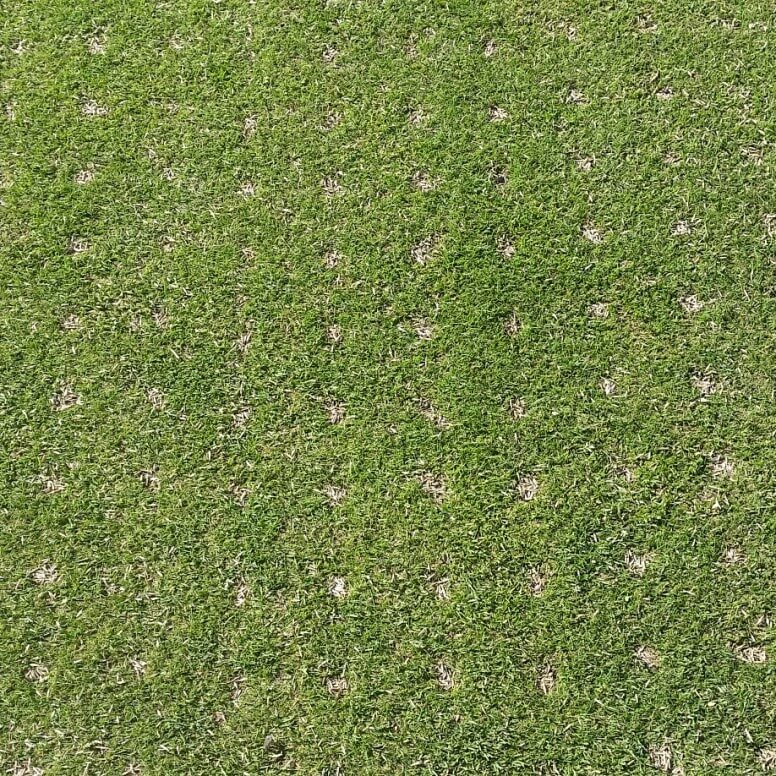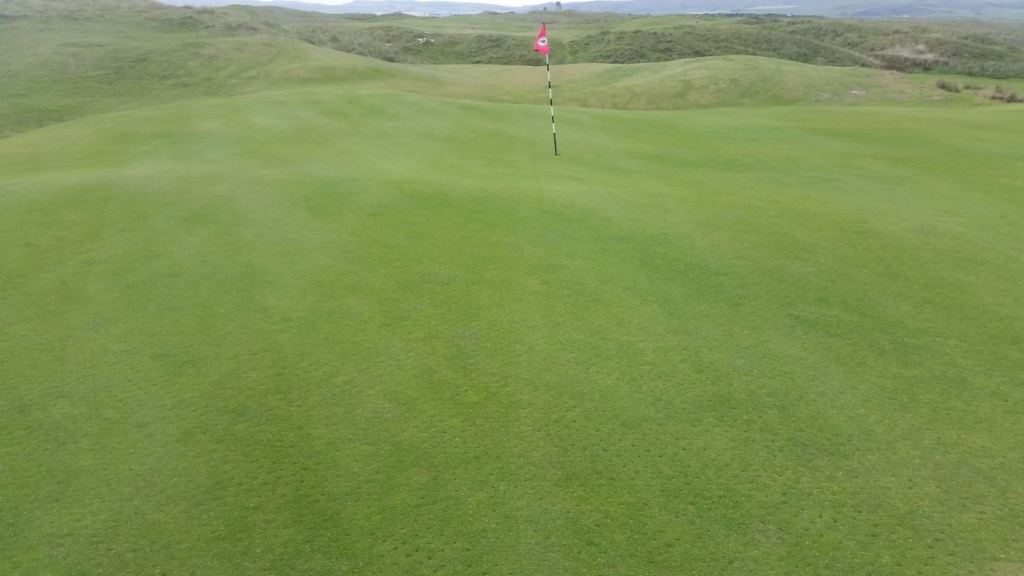Ok, I know there is still 6 weeks of proper golf season left before we even think about starting Winter projects and how to protect the course from the effects of Westerly gales, but typically the beginning of October is the time when we can mentally if not physically take our foot off the gas a bit. I’m not saying there is not plenty to do (there is actually a million things to do!), but once the days get a bit shorter and the peak daytime temperatures start to drop the necessity to be constantly on the ball to avoid potential catastrophic damage is replaced by the need to steadily toil away getting the playing areas prepared for the onslaught of Winter and ensuring that we have the greens, tees and fairways in even better shape going into next year. Yes, we are already thinking about next year. If you don`t think ahead, you`re falling behind!
This season has been relentless, and this is honestly the first time I have even had so much as a glance back to analyse how I think we have done. It seems like a lifetime since the Spring team challenge kicked off our year, but that early competition signalled the start of six weeks of outstanding weather that many people heralded as the beginning of the best Summer for 100 years. That turned out to be pretty much the worst prediction I’ve ever heard, for as soon as the utterance left their mouths the rain started and refused to stop, turning the fairways that had been baked and fast-running into grass factories that have really stretched the capabilities of our mower fleet. The greens that had been surviving just fine on a lean diet and an occasional sprinkle of water inevitably became hungry for nutrient and eventually, after several months of performing just the way we wanted them to, broke down and succumbed to a nasty outbreak of foliar anthracnose disease. The only way to deal with anthracnose is to properly feed the affected grass, which always pains us as it ruins the way balls run out on them and it makes it far more difficult for us to produce a decent surface to play on. In actual fact they have been ok though, we threw everything we had at them for the Black Sheep Open and most of the competitors seemed happy enough with them.
Which brings us to where we are now, with greens that have just been successfully aerated, overseeded and topdressed, tees which are lush and healthy (in direct contrast to how they appeared throughout the dry spell!) and fairways which look great when you cut them and then scruffy and hairy again the next day. There is a good stand of grass everywhere…even on that 5th green. Hopefully we will get a good mixture of weather through October so all that precious fescue seed we planted and germinated a few weeks ago will continue to mature and will help us through the Winter months so we can hit next season running, taking all that we learned this year with us!
The Frustration of Renovation
Ask any Scottish golfer whether they in all honesty think that Autumn aeration, overseeding and topdressing works are not just necessary but vital in order to ensure that the club`s greens staff keep their putting surfaces operating within a spiral of improvement rather than a spiral of decline and to a man they will tell you that they believe it is. Ask them why, and most of them will not be able to come up with a satisfactory answer. To me that is a pretty sad indictment on our complete failure to get the message regarding Autumn renovation across to them and to educate them as to exactly what it is that we are trying to achieve.
This year at Machrihanish Dunes we chose to focus on overseeding rather than aeration. We aerate regularly with solid tines throughout the year as a matter of course, which encourages air to circulate through the rootzones and helps create a favourable environment for microbes to break down thatch naturally. We also topdress with an 80/20 sand/soil mix on a very regular basis, which dilutes the organic matter that builds up on the surface when annual plant leaves die and grass clippings are inevitably spilled out of the mower boxes. In a way, we are building layered compost heaps on top of the green’s sandy base, which ensures that the surface hasn’t yet got soft, spongy and overly-rich enough for us to actually need to go hollow-coring. It takes a great deal of effort for us to build these rootzones up the way that we want them, so it would make no sense at all for us to remove that hard-earned preferential growing environment by tearing it out with hollow tines!
The solid tines we used during our recent program were much bigger in diameter than we would normally use, but this actually had little to do with a desire to increase the efficiency of the aeration. Fescue seeds are very large and it is difficult to integrate them into the soil profile using standard overseeding equipment, so we experimented with our Procore aerator fitted with a variety of different solid tines to see which diameter worked best to create a grid pattern of 1 inch deep holes for the precious seed to fall into. We found that the 10mm and 13mm tines made holes that were too small while the 19mm tines caused too much disruption to surfaces. Our solution was to run the 19mm tines over the tees first, then put them to work on the greens once they were worn in. This worked a treat, so we worked out a program where we would heavily topdress the green first, then aerate it, broadcast the seed using a fertiliser spreader and finally roll the greens out in two directions using handmowers fitted with stiff out-front brushes.

You can see from this first picture just how effective this program was in getting the seed into the holes. Excellent growing weather throughout September ensured that we got a massive germination strike just at the time we were starting to back away from pushing the greens to their limits, which allowed us every opportunity to bring these new plants to maturity. Overseeding successfully is all about timing and forward planning- if you seed too early in the hope of taking advantage of higher soil temperatures then you risk cutting the new seedlings back out as your maintenance program will be too aggressive for them to handle, whereas if you seed too late it might be too cold to germinate much seed at all.
The most important facet of our program this year was the way it was carefully structured to avoid surface damage and to minimise disruption. Most people would core first and then topdress the sand into the holes but I do not understand why anyone would do that- why haul a massive topdresser loaded with sand over a green that has just been decompacted? Not only does that negate the effect of the aeration but it also creates loads of ruts which are grim to putt over and will then cause your mower to scalp. A lot of people would also insist that a dedicated machine is required to integrate seed into the rootzone, but I have never found a dimple seeder yet that is capable of making big enough holes to capture a good percentage of fescue seed. This is why we used the massively versatile Procore to make holes which were not only the right diameter but also the right depth. The sandy topdressing we had already applied readily fell into the holes along with the seed, creating a suitably oxygenated environment in which the seed can now germinate and mature. I have a very good 6 foot wide brush that I normally tow behind a triple mower to brush topdressing off the surface and down into the area around the crown of the plant but on this occasion it was left in the shed in favour of using handmowers with outfront brushes to force seed and sand into the holes. Again this was a carefully planned attempt to ensure that we avoided damaging and rutting the surfaces so we could re-instate them to a playable condition as quickly as possible. The large roller on the back of these handmowers compacts the surface just enough to tap down any undulations on the green and to add sufficient firmness to resist further damage being caused by foot and future machine traffic. This second picture shows just how effective this program has been…it was taken two days later! Every single hole on this green is filled with seed and sand, and yet it is already not bad to putt on at all.

This programme would not suit every golf course, and of course to avoid hollow-coring in the future we will have to go back at regular intervals and solid spike with a variety of different tines set at a variety of different depths, but it does show how it is possible to take some of the pain out of Autumn renovations just by taking the time to think about how you can avoid tearing up and rutting the surface. A lot of the time there is just no need for it!
Renovation Rewards

The picture above was taken 8 days after the first pictures, and clearly shows the same grid pattern of holes now filled with fescue seedlings.
The germination we saw has been superb, with almost every hole filled with new grass plants which have now been brought to full maturity just in time, before the onset of more testing meteorological conditions. This entire program was completed with minimum disruption to our surfaces, and within the timescale for recovery that we were given. The picture below was taken on the morning of the Shepherd`s Cross, when the greens were rolling as good as they had been all year. Even though Craig has just mowed the 18th here, you can still clearly see all the lines of seedlings shining in the sun. It`s just a pity the whole day didn`t stay like that, but then it always seems to rain on the Shepherd`s Cross!!

What’s Up Next?
With the main competition schedule now over, members can look forward to our Winter League which starts on the 15th October. Every Sunday we will hold a simple stableford sweep, with cards from that day going towards an amalgamated 4 round total. The highest 4 round total stableford points score when the Winter League finishes at the end of March wins the league, so the more Sundays you can come and play the more chance you have of winning. Monthly medals will be played as stableford rather than strokeplay throughout the Winter months, so even scores from these competitions can count towards your 4 round total. We really hope to see a good number of people entering this league and competing on as many Sundays as possible. If you have any questions regarding this competition feel free to email me at simon@machdunes.com, or phone Lorna or Peter at the Golf House on 01586810058.
Enjoy your golf in this coming October!

